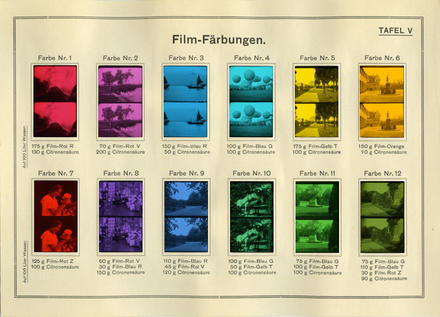Několik odkazů na zajímavé články
Historic tinting and toning guides are a major resource for the historic and scientific study of applied color in film preservation. The best known among these is Kodak’s Tinting and Toning of Eastman Positive Motion Picture Film, of which numerous copies and editions survive in archives, as well as in the library of the Haghefilm Foundation. The Foundation also holds a copy of Pathé Frères’ Manuel de Developpement et de Tirage from 1926. For that reason, it was all the more exciting to recently complete the collection of the major silent era tinting guides by the acquisition of two copies of the German version of the Agfa Kine Handbuch. Upon receiving these rare books, which like the Pathé and Kodak equivalent contain charts with actual, tinted and toned nitrate frames mounted in cardboard, we were surprised by the intense colors and pristine condition of the frames, surpassing anything we have seen in extant copies of the other books. Why are the Agfa samples in such good conditions, and does this explain their vibrant colors also? Chemical differences in the fixing, washing and tinting of the samples compared to the French and German samples might offer an explanation, but the quality of the mounting board can be a factor, too – acidic paper will certainly trigger and accelerate nitrate decomposition. However, an alternate, aesthetic explanation is offered by Elfriede Ledig’s seminal essay on silent movie color in her book Der Stummfilm, Konstruktion und Rekonstruktion. In footnote 59 (p.105) she dates the Agfa Kine book to 1921/22, as its toning recipes are replicated in another, 1922/23 source. Earlier in her essay, Ledig also elaborates on a shift towards lighter colors in the 1920s, substantiated by a 1921 quote from Urban Gad (p. 100). Does the Agfa book represent a snapshot of more vibrant tinting preferences prior to the mid-1920s, or is the reason for the colors a question of condition and thus rather chemical in nature? The question remains open for now, but is a strong reminder of the archeological importance of original film samples, and how color film preservation and study need to be informed as much by technical and scientific as by historic and aesthetic judgment. - Ulrich Ruedel (submitted February 25, 2010)
Text a obrázek z http://www.haghefilmfoundation.org/Research.html
